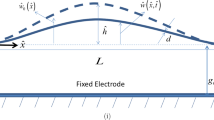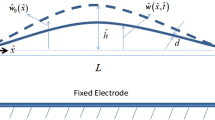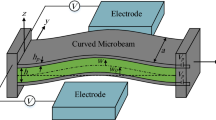Abstract
In this work, we investigate the structural behavior of a micro-electromechanical system arch microbeam actuated by electric fringing-fields where the electrodes are located at both side of the microbeam. In this particular configuration, the electrostatic actuating force is caused by the asymmetry of the fringing electric fields acting in a direction opposite to the relative deflection of the microbeam. A reduced-order model is derived for the considered system using the so-called Galerkin decomposition and assuming linear undamped mode shapes of a straight beam as basis functions in the decomposition process. A static analysis is performed to investigate the occurrence of any structural instability. The eigenvalue problem is then investigated to calculate the fundamental as well as higher natural frequencies variation of the microbeam with the applied DC load. A bifurcation analysis is then implemented to derive a criterion for whether symmetric or asymmetric bifurcation is occurring during the static structural instability. The results show elimination of the so-called pull-in instability in this kind of systems as compared to the regular case of parallel-plates electrostatic actuation. The bifurcation analysis shows that the arch goes for asymmetric bifurcation (symmetry breaking) with increase in initial elevation without the occurrence of symmetric bifurcation (snap-through) for any initial elevation.
















Similar content being viewed by others
References
Abdel-Rahman EM, Nayfeh AH (2005) Contact force identification using the subharmonic resonance of a contact-mode atomic force microscopy. Nanotechnology 16(2):199
Arafat H, Nayfeh A, Abdel-Rahman E (2008) Modal interactions in contact-mode atomic force microscopes. Nonlinear Dyn 54(1–2):151–166
Bassous E, Taub HH, Kuhn L (1977) Ink jet printing nozzle arrays etched in silicon. Appl Phys Lett 31(2):135–137
Bochobza-Degani O, Elata D, Nemirovsky Y (2002) An efficient DIPIE algorithm for CAD of electrostatically actuated MEMS devices. Microelectromech Syst J 11(5):612–620
Casals-Terre J, Fargas-Marques A, Shkel AM (2008) Snap-action bistable micromechanisms actuated by nonlinear resonance. Microelectromech Syst J 17(5):1082–1093
Chan EK, Garikipati K, Dutton RW (1999) Characterization of contact electromechanics through capacitance-voltage measurements and simulations. Microelectromech Syst J 8(2):208–217
Charlot B, Sun W, Yamashita K, Fujita H, Toshiyoshi H (2008) Bistable nanowire for micromechanical memory. J Micromech Microeng 18(4):045005
Das K, Batra RC (2009) Symmetry breaking, snap-through and pull-in instabilities under dynamic loading of microelectromechanical shallow arches. Smart Mater Struct 18(11):115008
Go JS, Cho Y-H, Kwak BM, Park K (1996) Snapping microswitches with adjustable acceleration threshold. Sens Actuators, A 54(1–3):579–583
Goldsmith CL, Yao ZJ, Eshelman S, Denniston D (1998) Performance of low-loss RF MEMS capacitive switches. Microw Guided Wave Lett IEEE 8(8):269–271
Intaraprasonk V, Shanhui F (2011) Nonvolatile bistable all-optical switch from mechanical buckling. Appl Phys Lett 98(24):241104
Krylov S, Ilic BR, Schreiber D, Seretensky S, Craighead H (2008a) The pull-in behavior of electrostatically actuated bistable microstructures. J Micromech Microeng 18(5):055026
Krylov S, Seretensky S, Schreiber D (2008) Pull-in behavior and multistability of a curved microbeam actuated by a distributed electrostatic force. In: Micro Electro Mechanical Systems, 2008. MEMS 2008. IEEE 21st International Conference, 2008, pp 499–502
Krylov S, Ilic B, Lulinsky S (2011) Bistability of curved microbeams actuated by fringing electrostatic fields. Nonlinear Dyn 66(3):403–426
Lee KB (2007) Non-contact electrostatic microactuator using slit structures: theory and a preliminary test. J Micromech Microeng 17(11):2186
Linzon Y, Ilic B, Lulinsky S, Krylov S (2013) Efficient parametric excitation of silicon-on-insulator microcantilever beams by fringing electrostatic fields. J Appl Phys 113(16):163508–163511
Liwei L, Howe RT, Pisano AP (1998) Microelectromechanical filters for signal processing. Microelectromech Syst J 7(3):286–294
Medina L, Gilat R, Krylov S (2012) Symmetry breaking in an initially curved micro beam loaded by a distributed electrostatic force. Int J Solids Struct 49(13):1864–1876
Medina L, Gilat R, Krylov S (2013) Symmetry breaking criteria in electrostatically loaded bistable curved/prebuckled micro beams. In: Malomed BA (ed) Spontaneous symmetry breaking, self-trapping, and josephson oscillations. Springer, Berlin, pp 679–705
Nathanson HC, Newell WE, Wickstrom RA, Davis JR Jr (1967) The resonant gate transistor. Electron Devices IEEE Trans 14(3):117–133
Nayfeh AH, Pai PF (2008) Linear and nonlinear structural mechanics. Wiley, New York
Nayfeh AH, Younis MI (2005) Dynamics of MEMS resonators under superharmonic and subharmonic excitations. J Micromech Microeng 15(10):1840
Nayfeh A, Younis M, Abdel-Rahman E (2005) Reduced-order models for MEMS applications. Nonlinear Dyn 41(1–3):211–236
Newell WE (1968) Miniaturization of tuning forks. Science 161(3848):1320–1326
Ouakad HM (2013) An electrostatically actuated MEMS arch band-pass filter. Shock Vib 20(4):809–819
Ouakad HM (2014) Static response and natural frequencies of microbeams actuated by out-of-plane electrostatic fringing-fields. Int J Non Linear Mech 63:39–48
Ouakad HM, Younis MI (2010) The dynamic behavior of MEMS arch resonators actuated electrically. Int J Non Linear Mech 45(7):704–713
Ouakad HM, Younis MI (2014) On using the dynamic snap-through motion of MEMS initially curved microbeams for filtering applications. J Sound Vib 333(2):555–568
Pane IZ, Asano T (2008) Investigation on bistability and fabrication of bistable prestressed curved beam. Jpn J Appl Phys 47(6S):5291
Park S, Hah D (2008) Pre-shaped buckled-beam actuators: theory and experiments. Sens Actuators, A 148(1):186–192
Rebeiz GM (2004) RF MEMS: theory, design, and technology. Wiley, New York
Receveur RAM, Marxer CR, Woering R, Larik VCMH, de Rooij NF (2005) Laterally moving bistable MEMS DC switch for biomedical applications. Microelectromech Syst J 14(5):1089–1098
Rossiter J, Stoimenov B, Mukai T (2006) A self-switching bistable artificial muscle actuator. In: SICE-ICASE, 2006. International Joint Conference, 2006, pp 5847–5852
Roylance LM, Angell JB (1979) A batch-fabricated silicon accelerometer. Electron Devices IEEE Trans 26(12):1911–1917
Saif MTA (2000) On a tunable bistable MEMS-theory and experiment. Microelectromech Syst J 9(2):157–170
Soper SA, Wang W (2006) Bio-MEMS: technologies and applications. CRC/Taylor & Francis, Boca Raton
van Kessel PF, Hornbeck LJ, Meier RE, Douglass MR (1998) A MEMS-based projection display. Proc IEEE 86(8):1687–1704
Yin Z, Yisong W, Zhihong L, Yubo H, Dachao L (2007) Snap-through and pull-in instabilities of an arch-shaped beam under an electrostatic loading. Microelectromech Syst J 16(3):684–693
Younis M (2011) Microbeams: MEMS linear and nonlinear statics and dynamics. Springer, USA, pp 251–357
Younis MI, Nayfeh AH (2003) A study of the nonlinear response of a resonant microbeam to an electric actuation. Nonlinear Dyn 31(1):91–117
Younis MI, Abdel-Rahman EM, Nayfeh A (2003) A reduced-order model for electrically actuated microbeam-based MEMS. Microelectromech Syst J 12(5):672–680
Younis MI, Ouakad HM, Alsaleem FM, Miles R, Weili C (2010) Nonlinear dynamics of MEMS arches under harmonic electrostatic actuation. Microelectromech Syst J 19(3):647–656
Author information
Authors and Affiliations
Corresponding author
Rights and permissions
About this article
Cite this article
Mohammad, T.F., Ouakad, H.M. Static, eigenvalue problem and bifurcation analysis of MEMS arches actuated by electrostatic fringing-fields. Microsyst Technol 22, 193–206 (2016). https://doi.org/10.1007/s00542-014-2372-8
Received:
Accepted:
Published:
Issue Date:
DOI: https://doi.org/10.1007/s00542-014-2372-8




